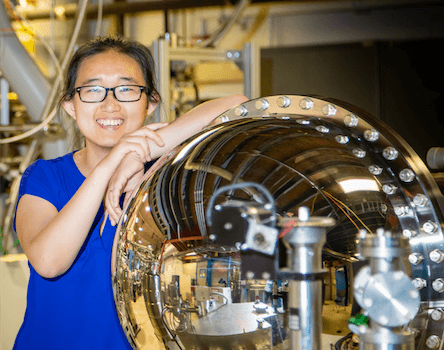 From superconductors to snowboarding, Ming Yi sees the beauty of physics everywhere. She loves the sense of community in the synchrotron world and hopes users and staff will share their input with the Users’ Executive Committee.
From superconductors to snowboarding, Ming Yi sees the beauty of physics everywhere. She loves the sense of community in the synchrotron world and hopes users and staff will share their input with the Users’ Executive Committee.
What led you to join the UEC, and what is your “day job” outside of the UEC?
I’m a physics assistant professor at Rice University. I’ve been here for a little over three years now. When I was a graduate student at Stanford, I followed my mentor up the hill to the ALS for my very first synchrotron experiment, and that left a really deep impression on me—both the scenery across the bay and also the beautiful data that came out of the machine. I’ve been a user at the ALS ever since.
After my PhD, I went to Berkeley to do a postdoc, and my office mate was Alex Frano, who was the UEC chair two years back. We’ve remained friends, and he kept telling me about the UEC, how you meet wonderful people and learn a lot about synchrotron radiation and the synchrotron community, so that motivated me. That’s how I ended up on the UEC.
Do you remember what that first experiment was?

Definitely. Right when I joined my PhD group, a new class of high-temperature superconductors were discovered, the iron-based superconductors. The experiment we did was to measure the band structure of one of these first crystals that our collaborators made. We used angle-resolved photoemission spectroscopy (ARPES)—the electrons come out of the material after being kicked out by the synchrotron radiation, and we map the pattern of the electrons to directly image the electronic states. I vividly remember the images coming out on the computer screen slice by slice, and they were piecing together to reveal this beautiful symmetric pattern of the Fermi surface that was mirroring the rising moon in the dark sky in the wee hours of the morning when everything’s quiet (except the pumps). That must have triggered something deep inside because I’m still at it more than a decade later.
Do you like when everything’s quiet, or do you prefer when there are a lot of people on the experimental floor?
Both! During my grad school days, when I went to the beamline, there would be people there measuring from the previous group, and then there’d be people coming after us, so I met a lot of ARPES graduate students from different groups. I really loved that sense of community that we built just from having beamtime. Of course, in the wee hours of the morning, you also bond with people you have beamtime with, that you pull all-nighters with. It’s a full experience.
How is the UEC involved in fostering that sense of community?
I previously only met people who were doing photoemission. Through the UEC, I’ve met people who are in different areas of science, and besides users, I’ve also met beamline scientists, staff, communicators, and upper management as well. It’s a community of people, both enabling the science and making sure it reaches the public.
These past couple years, we haven’t been on-site because of the pandemic. So, Dula Parkinson led a workshop at last year’s User Meeting to discuss the difficulties and capabilities we’d like to see for remote operations. We surveyed the user community to understand people’s experiences and what they’d like to see in the future—maybe hybrid modes. Another interesting part of a past User Meeting was a diversity panel in 2020. I got to be a panelist, and we discussed balancing work and life, and what it means to have a diverse user community. With the upcoming User Meeting, we hope to do more of this, especially in collaboration with the Inclusion, Diversity, Equity, and Accountability (IDEA) Committee, to try to reach a broader audience. We really welcome communication and suggestions from the users and staff.
How did you become interested in physics?
Out of the three high school sciences, I found physics to require the least memorization. You can see an organizational framework of all the concepts, and everything’s connected. I really like the beauty of the way that physics describes science. My first college physics class was taught by a female professor in high energy physics. She encouraged me to join her research group. That was my first taste of research, and I really enjoy that aspect of peeking at the unknown.
What do you like to do in your free time?
I hang out with my kids. They’re at an impressionable age where they’re starting to ask questions. We were just watching the halfpipe snowboarding event in the winter Olympics where the athletes sway from one side to the other trying to jump high, and I pointed out to them how the snowboarders always go the highest at the first jump, and then once they fall, they can’t jump back up anymore. They asked why, so I tried to explain the conservation of energy and friction. They know mommy’s a scientist, so they bring me all the interesting questions!